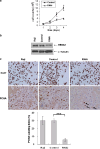Suppression of Epstein-Barr nuclear antigen 1 (EBNA1) by RNA interference inhibits proliferation of EBV-positive Burkitt's lymphoma cells
- PMID: 16180023
- PMCID: PMC12161018
- DOI: 10.1007/s00432-005-0036-x
Suppression of Epstein-Barr nuclear antigen 1 (EBNA1) by RNA interference inhibits proliferation of EBV-positive Burkitt's lymphoma cells
Abstract
Purpose: Epstein-Barr virus (EBV) is associated with the development of several lymphoid and epithelial malignancies, including Burkitt's lymphoma. The EBV latent protein, EBV Nuclear Antigen 1 (EBNA1), is detectable in almost all types of EBV-associated tumors and is essential for replication and maintenance of the latent episome of EBV. We here examined whether the RNA interference (RNAi) technique could be employed to suppress expression of EBNA1 in EBV-positive Burkitt's lymphoma cells.
Methods: A Raji cell line expressing small hairpin RNAs (shRNAs) against EBNA1 was established and EBNA1 mRNA level was determined by real-time RT-PCR analysis. We investigated the effects of EBNA1 silence on lymphoma cell growth and cell cycle progression.
Results: Transfection of an EBNA1 RNAi plasmid resulted in substantial loss of EBNA1 mRNA and significantly inhibited proliferation of Raji cells relative to the control plasmid case. Suppression of EBNA1 was also associated with downregulation of EBV oncogene EBNA2, a decreased PCNA labeling index and increased G0/G1 fraction in cell cycle analysis.
Conclusions: These findings point to potential therapeutic applications for vector-mediated siRNA delivery to control EBV-associated malignant disorders.
Figures




References
-
- Brummelkamp TR, Bernards R, Agami R (2002) A system for stable expression of short interfering RNAs in mammalian cells. Science 296:550–553 - PubMed
-
- Butz K, Ristriani T, Hengstermann A, Denk C, Scheffner M, Hoppe-Seyler F (2003) siRNA targeting of the viral E6 oncogene efficiently kills human papillomavirus-positive cancer cells. Oncogene 22:5938–5945 - PubMed
Publication types
MeSH terms
Substances
LinkOut - more resources
Full Text Sources
Miscellaneous

